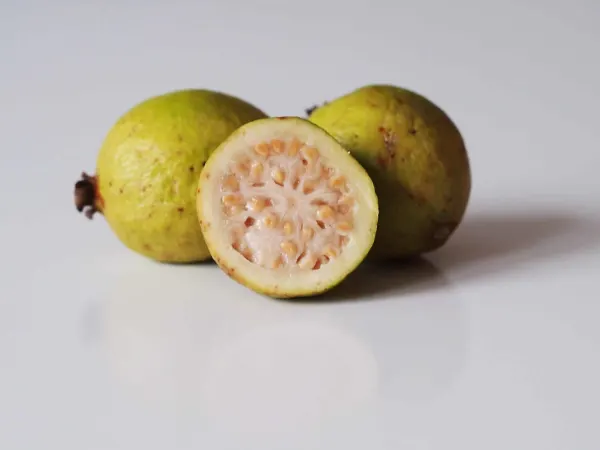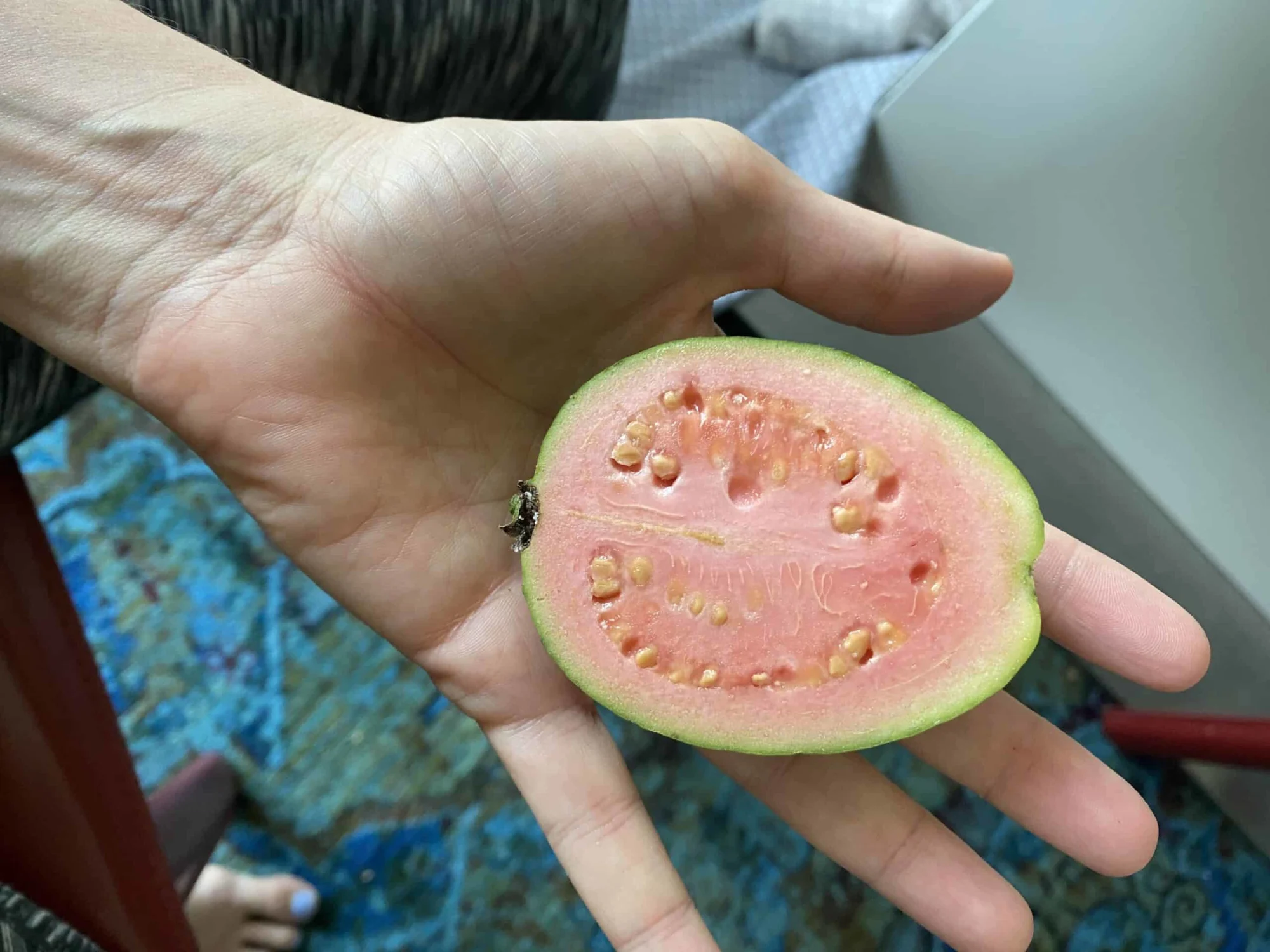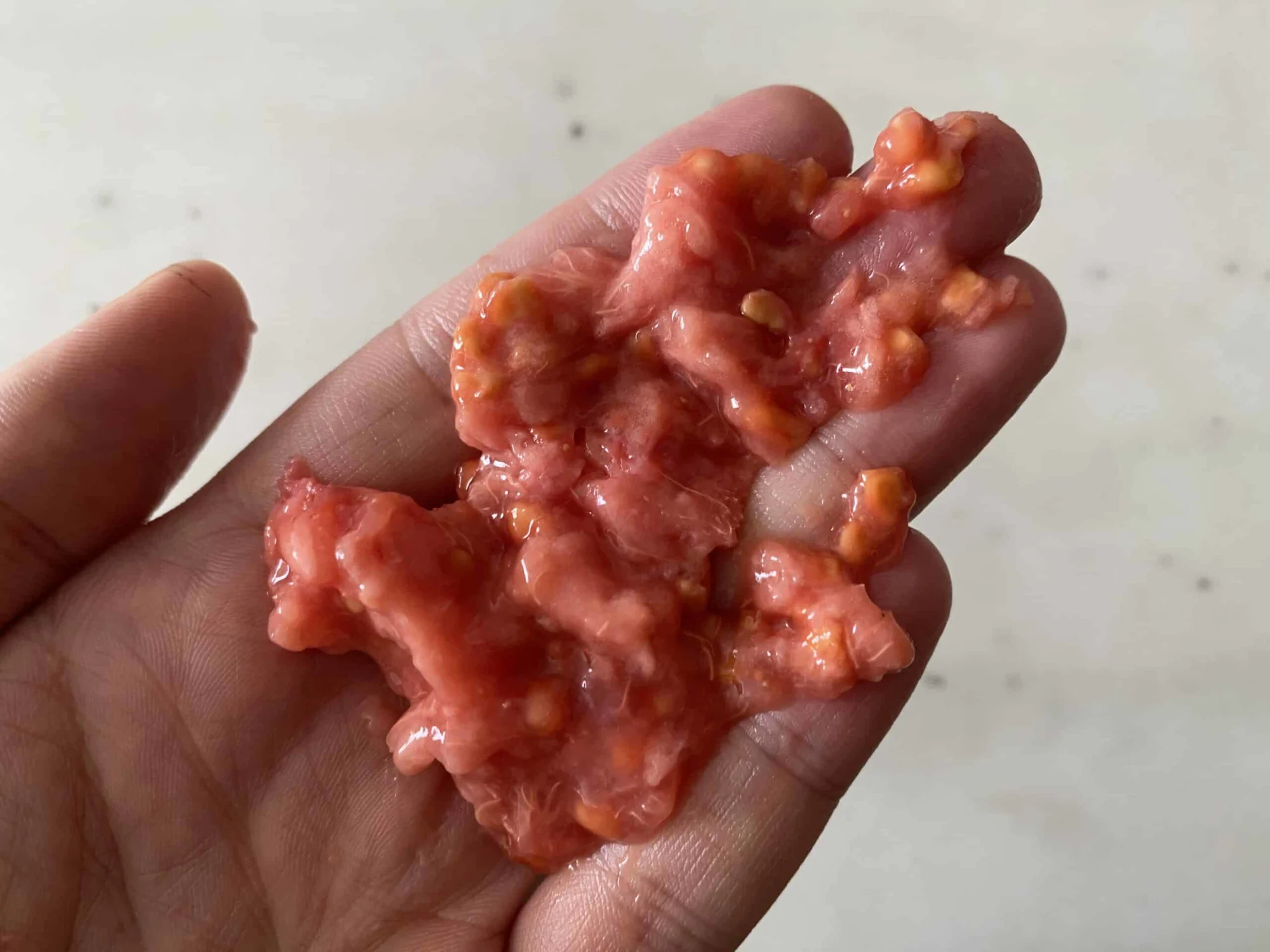Access our First Foods® Database in the Solid Starts App.
Learn moreGuava (Soft)
Fruit
Age Suggestion
6 months
Iron-Rich
No
Common Allergen
No

When can babies eat guava?
Soft types of guava may be introduced as soon as baby is ready to start solids, which is generally around 6 months of age. There are hundreds of guava varieties in the world, and they vary widely in texture and consistency, which means they also vary widely in terms of choking risk. From the soft and smooth Mexican Cream guava to the firm, apple-like white guavas, take care to consider any characteristics that might increase the risk of choking (firmness, roundness, slipperiness) or aspiration (loose seeds). For information on firm guava varieties, known variously as amrood, farang, and jambu batu, see Guava (Firm).
How do you introduce soft guavas to babies with baby-led weaning?
Every baby develops on their own timeline, and the suggestions on how to cut or prepare particular foods are generalizations for a broad audience.
6 to 9 months old:
There are a few options for serving soft varieties of guava to babies just starting solids. The most conservative option is to cut guava in half and then scoop out the flesh and strain the seeds out. Mash deseeded fruit into a guava sauce and play with enhancers like butter or yogurt for extra fat or seasonings like cardamom, cayenne, cinnamon, or ginger for zingy flavor. Refrain from adding sugar or offering preserved guava products like jam, jelly, paste, or syrup at this age. If the guava is golf ball sized or larger and is soft (similar texture to a strawberry) you can also try cutting it in half, removing the seeds by scooping out the center flesh, then handing over the whole half of the guava to baby to gnaw on.
9 to 12 months old:
Mash guava and fold into other foods such as warm cereal or yogurt. If you feel comfortable, leave the seeds in. While not a choking hazard, the seeds can be aspirated, though this is less of a risk if the seeds remain embedded in the fruit flesh and the guava is mixed with other food. If you feel baby has well developed chewing skills at this point and is managing other unmashed pieces of fruits, such as banana, plum or watermelon, you can try serving smaller diced pieces of soft guava (with the skin and seeds) for baby to finger feed. Removing the seeds will make these pieces easier for baby to manage, as the seeds are meant to be swallowed whole along with the pulp and may lead to gagging or coughing.
12 to 18 months old:
At this age, you can experiment with using fresh chopped or diced soft guava to flavor foods like fruit salad or puree guava into smoothies. Continue to remove the seeds if you like though this may not be necessary at this age for babies who have lots of experience chewing and swallowing a variety of food textures. As always, stay within arm’s reach during mealtime and refrain from offering raw guava, even deseeded and diced guava, in strollers or car seats.
18 to 24 months old and up:
Time for the next step! If you haven’t already, now is a great time to consider serving soft ripe quarters, halves and even whole guavas. Choose one that is soft like a strawberry and large enough that the child cannot easily put the whole thing in their mouth so they must bite into it. Whole guava can actually be safer than larger sections of raw guava, such as a quarter of a guava, that can fit inside the mouth without biting into it. The riper and softer the guava, the easier it will be for the child to chew it well before swallowing, which should decrease the risk. You can keep the skin on but go ahead and peel it if the child struggles with fruit skin. You can also try peeling the skin in “stripes” so that some is left on for variety and exposure to fruit skin. When you feel the child understands instructions, model how to use teeth to bite into and scrape out the juicy flesh, pulp, and tiny seeds from the skin and let the child try on their own. Be sure to stay within an arm’s reach in case you need to help. If you feel the child is not ready for fruit with seeds, continue to offer deseeded slices or bite-sized pieces of cooked guava – or mash and mix guava into soft foods like oatmeal, smoothies, or yogurt.


Pink guava vs. a firm style white guava.
If you are stuck in a puffs and pouches rut, check out our snack guide for 100 healthy and easy ideas for babies and toddlers.
Videos
Is guava a common choking hazard for babies?
No, though even soft types of guava have edible seeds that can be tricky to manage and may present an aspiration risk. To minimize the risk, strain the seeds out and use the pulp for sauces, etc. As always, make sure to create a safe eating environment and stay within arm’s reach of baby at mealtime.
For more information on choking, visit our sections on gagging and choking and familiarize yourself with the list of common choking hazards.
Is guava a common allergen?
No. Allergies to guava and guava byproducts (such as guava leaf) are rare, but have been reported. Individuals with allergies to latex may be sensitive to guava. Individuals with Oral Allergy Syndrome who are allergic to birch pollen may be sensitive to guava. Oral Allergy Syndrome typically results in short-lived itching, tingling, or burning in the mouth and is unlikely to result in a dangerous reaction. Fortunately, peeling or cooking the fruit can help minimize or even eliminate the reaction.
As you would do when introducing any new food, start by offering a small amount for the first few servings. If there is no adverse reaction, gradually increase the amount served over future meals.
Is guava healthy for babies?
Yes. Guava is loaded with nutrients that they need to fuel their rapid growth. Guava offers fiber, B-vitamins (including vitamin B6 and folate), vitamin E, and potassium. The fruit is also packed with vitamin C to help the body build connective tissue, promote a healthy immune system, and absorb iron from plant-based foods. In fact, guava contains more than four times as much vitamin C as an orange. That’s not all: guava also contains a healthy dose of plant-based omega 3 fatty acids to support brain and visual health. Guava is rich in polyphenols, which are beneficial plant nutrients that, in this case, are antioxidative, anti-cancerous, anti-microbial, and anti-inflammatory. Lastly, guava is an excellent source of fiber, specifically insoluble fiber, which is great for poop but can cause gas and bloating if too much is consumed. For this reason, it may be best to start slow and gradually increase the amount offered.
★Tip: If fresh guava is not available, try frozen guava pulp and be sure to read the label before purchasing. Opt for packages that contain simply “guava” or “guava pulp” and no added sweeteners or syrups, which are way too sugary for children.
Origins of guava
Guava originated in the tropics of the Americas, where the Arawak people learned to harvest the plant that they called guayabo for its delicious fruit. As colonization and trade took guava seeds to South Asia and other parts of the world, the fruit proliferated in dry and humid climates alike, an evolutionary leap that led to hundreds of varieties grown today. Some guavas are sweet, others are sour, and each has edible skin that ranges from creamy white to lime green to golden pink to crimson. Size ranges, too: there are guavas that are as large as a grapefruit, while others are shaped like a pear. There are even guavas that are so tiny that adults can eat them in one bite like a grape.
Certain varieties of guava—including Mexican Cream, Hawaiian White, and most pink-fleshed types—become very soft when ripe. As the fruit matures, the hue of its skin shifts and gains a strong, sweet smell. The flesh inside these types ranges from creamy white to pale yellow touched with pink to bright pink and is much juicier than the firm varieties of guava.
★Tip: Ripe guavas have an intense aroma and a little give when pressed in your palm – like a ripe banana, mango, or pear. Store unripe guava at room temperature until ripe, then transfer to the refrigerator, where the fruit keeps for about a week.
Our Team
Written by
Expert Tips Delivered to Your Inbox
Sign up for weekly tips, recipes and more!
Copyright © 2025 • Solid Starts Inc






